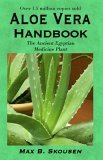What is Aloe Vera?
Aloe vera belongs to the lily family. Its cactus-like appearance is due to its semi-arid to arid habitat. Aloe vera is a succulent. The leaves are relatively thick, fleshy and store water. There are about 200 types of aloes. Only very few have healing properties. Aloe barbadensis miller (aloe vera) is deemed most effective.
Two raw materials are extracted from the leaves of the aloe vera plant: :
- The so called aloe vera gel is extracted from the leaf pulp.
- Aloe vera juice can be extracted from the pure gel, as well as from the rind and gel (Brazil) or if used as a laxative only from the rind.
top 

Aloe Vera Handbook: The Acient Egyption Medicine Plant

Aloe Vera : Nature's Soothing Healer
|
Effect of Aloe Vera
Aloe vera is considered as an all around product in naturopathy. Aloe vera is one of the oldest and most time-tested medicinal plants.
Aloe vera gel is meant to effective on external wounds, burns, skin irritations, radiation injuries as well as neurodermatitis.
Internal use of aloe vera is meant to help against constipation, coughing, headaches, allergies, rheumatic fever, heart diseases, HIV infections and cancers.
Aloe vera-juice is especially effective as a laxative.
Evaluation of Aloe Vera
There are very few established scientific studies on the effect of aloe vera. Aloe vera is not a miracle medication. The only scientifically proven effect of aloe vera is the internal use of aloe vera juice as a laxative. However if using aloe vera juice as a laxative one must bear in mind that the active substance (anthraquinone) has a possible carcinogenic effect.
The cosmetic industry has been using the moisturising effect of aloe vera gel in skin care products for a very long time.
When buying aloe vera products, make sure that aloe vera is really the main component of the ingredients. Aloe vera should be right at the start of the list of ingredients.
top 
|

